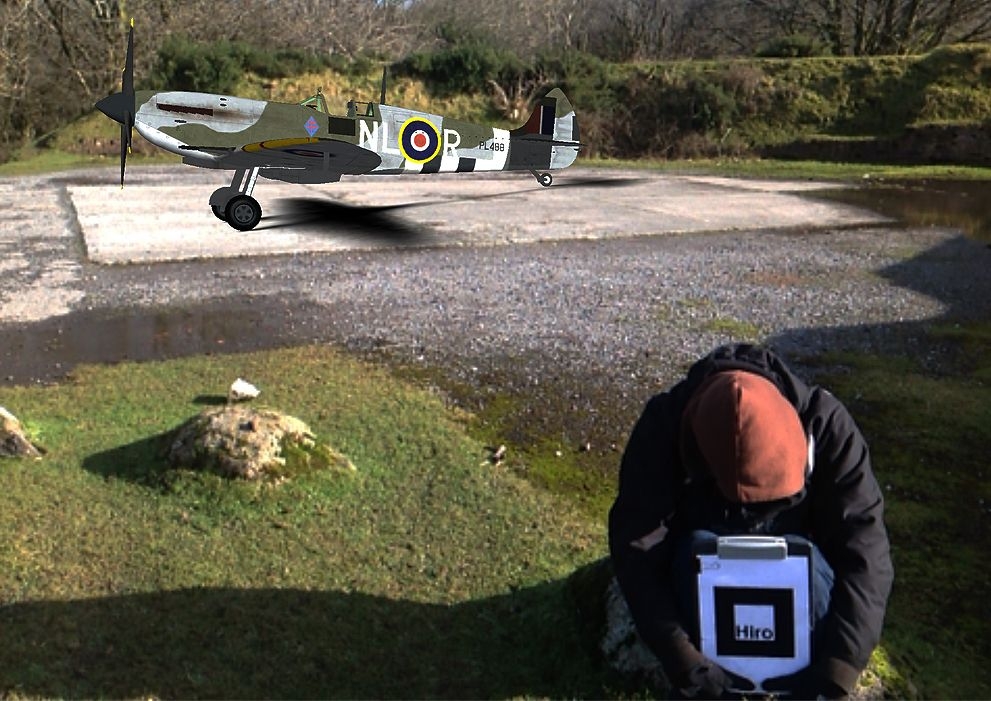
Staff and students from the School of EESE have been conducting investigations of field-based Augmented Reality (AR) in Devon recently where, amongst other examples, they recreated the experience of a World War II Spitfire preparing for taxiing within the remains of a dispersal pen at the long-abandoned RAF airfield of Harrowbeer, near Yelverton. EESE PhD student Yuqing Gao is currently researching novel ways to improve location tracking and virtual object registration techniques to support effective mobile AR technologies as, despite impressive marketing claims, current commercial products fall far short of an acceptable markerless-based experience when taken out of the laboratory and into the field. As well as witnessing the real-world problems of AR first-hand, aided and abetted by another School PhD student Jamie White (seen in the image holding an AR marker in the freezing northerly Dartmoor wind!), Gao’s first trip to the British countryside demonstrated the future challenges her research faces having selected as her AR project focus the ruins of Longstone Manor, originally built in 1500 and abandoned in 1895 just before the area was flooded to produce Burrator reservoir.

Since the summer of 2012 the Human Interface Technologies (HIT) Team’s Digital Healthcare and Heritage activities have been gathering significant pace. One hitherto unexplored link, which came to light after the Virtual Wembury and HMS Amethyst projects of last summer, relates to how we can exploit digital reconstructions of real-world locations not only to provide hospitalised patients with rich interactive experiences, but also to encourage individuals and groups from all walks of life to venture out and to experience the benefits the real natural world has to offer. Specifically, the Team is now engaging with a number of conservation, healthcare and heritage groups to investigate how we can achieve this by endowing the real world with rich, discoverable, virtual cultural and historical artefacts, made accessible using appropriately-fielded VR and AR technologies. The Team also believes that such digital environments, when presented to individuals and groups using appropriate interactive formats at appropriate venues (real-world or online), can also encourage cross-generation and cross-community engagement and thus help to uncover information, assets and narratives that would have otherwise been lost to future beneficiaries.

As well as generating excellent journal publication and conference presentation opportunities, two websites detailing some of the team’s activities in South Devon are now live (www.virtualburrator.net and www.virtual-wembury.net). Meetings have been held with the Dartmoor National Park Authority and South West Lakes to discuss future projects and grant applications, including an exciting multi-beam echo sounder survey of part of Burrator Reservoir to generate data suitable for an interactive 3D reconstruction of the once inhabited areas of the valley region prior to its flooding in 1898. Other projects involve the virtual recreation of two historic maritime events in Plymouth Sound, separated in time by nearly 200 years. The first is a reconstruction of a vessel called the Maria. Purchased by a carpenter called John Day in the 1770s for £340, this 31-foot wooden sloop entered the history books as being host to the first recorded submariner fatality. The second is based on an event that took place in September 1965, when two British Sub-Aqua Club divers, Colin Irwin and John Heath, spent a week living within a 2-ton, 3.7m long and 2.1m diameter cylinder called GLAUCUS at a depth of 10.7m (35ft), just off the Plymouth Breakwater. One of the aims of this project was to demonstrate that living in underwater habitats could be achieved on a much smaller budget than that being expended at the time by, for example, Jacques Cousteau’s Conshelf Project team.
